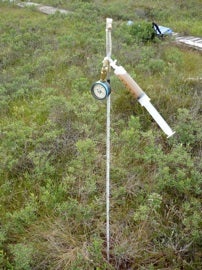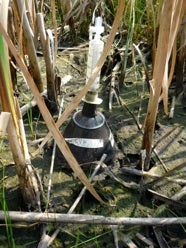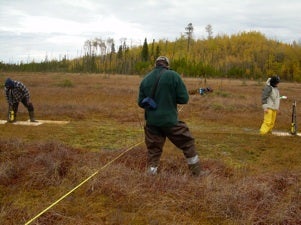Waterlogged conditions in peatland soils result in anaerobic decomposition of organic matter resulting in gaseous end-products including methane. At low concentrations these gases are dissolved, but continued production often results in production and growth of entrapped gas bubbles. These bubbles influence peatland hydrology and biogeochemistry and their release to the atmosphere is likely a major source of the methane released from these ecosystems.
We are working to quantify subsurface entrapped gas stocks, understand controls on the spatial patterns of these stocks and measure their release to the atmosphere.

Subsurface sampling of water and gas to estimate methane stock

Gas trap to measure bubble release

Estimating subsurface entrapped gas stock using ground penetrating radar (GPR)
Related publications:
- Comas X, Kettridge N, Binley A, Slater L, Parsekian A, Baird AJ, Strack M, Waddington JM. 2013. The effect of peat structure on the spatial distribution of biogenic gases within bogs, Hydrological Processes, doi: 10.1002/hyp.10056.
- Strack M, Mierau T. 2010. Evaluating spatial variability of free-phase gas in peat using ground penetrating radar and direct measurement. Journal of Geophysical Research – Biogeosciences, doi: 10.1029/2009JG001045.
- Strack M, Waddington JM. 2008. Spatio-temporal variability of subsurface CH4 in peatlands. Journal of Geophysical Research – Biogeosciences, 113, G02010, doi: 10.1029/2007JG000472.
- Strack M, Kellner E, Waddington JM. 2006. Effect of entrapped gas on peatland surface level fluctuations. Hydrological Processes, 20, 3611-3622, doi: 10.1002/hyp.6518
- Strack M, Kellner E, Waddington JM. 2005. The dynamics of biogenic gas bubbles in peat and their effects on peatland biogeochemistry. Global Biogeochemical Cycles, 19, GB1003, doi: 10.1029/2004GB002330.